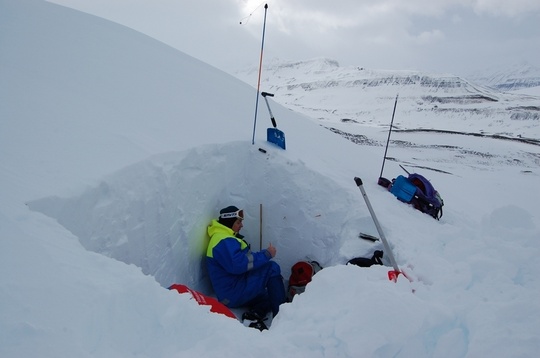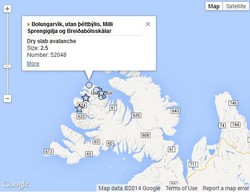Avalanche notices on the web - an improved map
Last ten days' avalanches presented on an interactive map
Notices on recent avalanches have been given on the web since April 2012 but an improvement has been made to this presentation.
The map is now interactive; zoom into any area of the country to receive information on avalanche notices from the last ten days and click on a symbol representing each event for further information. On the map, the time elapsed since the avalanche fell is color-coded but the size of an avalanche is given by the symbol (see classification below). In an adjacent table, notices on recent avalanches in the country can be sorted by any key factor.
Most notices come from regions where avalanche observers work and it is imperative that the users of the web understand that more avalanches are likely to have fallen without being reported. Accordingly, people are encouraged to report avalanches that they come across.
Other services
The avalanche warning service of the Icelandic Meteorological Office monitors impending avalanche danger in towns and villages in Iceland on a daily basis during the winter season. Real-time information about snowpack conditions and avalanche danger that is gathered as a part of this monitoring, is potentially useful for inhabitants of rural areas and travellers on roads and in the backcountry.
An avalanche forecast is made for three selected high-risk areas in Iceland. It doesn't necessarily represent avalanche danger for urban sites in these areas.
General information about snow avalanches in Iceland is available on the web, as well as information about IMO's responsibility with regard to avalanches and a few articles on the subject.
An overview is given through the avalanches front-page or the avalanches main tab.

EAWS avalance size classification
Avalanche size. Extent of the avalanche, classified by destructive potential and runout length.
Size 1 Sluff Minimal danger of burying (danger of falling) Snow relocation stops typically before the end of a slope
Size 2 Small Avalanche Could bury, injure or kill a person Snow avalanche stops typically at the end of a slope
Size 3 Medium Avalanche Could bury and destroy a car, damage a truck, destroy a small building or break a few trees Snow avalanche could traverse flat terrain (consideralbly below 30°) over distances of less than 50m
Size 4 Large Avalanche could bury and destroy a railway car, large trucks, several buildings or a piece of forest Snow avalanche traverses flat terrain (considerably below 30°) over distances more than 50m and can reach valley ground
Size 5 Very large Avalanche Could gouge the landscape. Disastrous damage potential Snow avalanche reaches valley ground. Largest runout distance known




